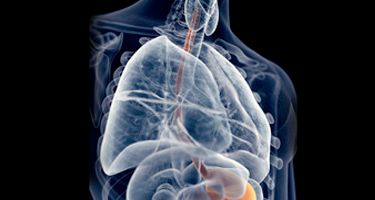Esophageal Procedures

Esophagectomy and Esophageal Resection
Esophagectomy and esophageal resection are surgical procedures that involve the removal of a portion, or all, of the esophagus, surrounding lymph nodes and sometimes a portion of the stomach. Most frequently, an esophagectomy and an esophageal resection are performed to treat early-stage cancer of the esophagus before the cancer has metastasized to the stomach or other organs. These procedures may also be a treatment for Barrett's esophagus or esophageal dysplasia, precancerous conditions of the cells lining the esophagus. Less often, an esophagectomy and esophageal resection are performed when there has been irreversible damage to the esophagus as a result of traumatic injury, the swallowing of a caustic substance, chronic inflammation or motility issues which interfere with the passage of food during the digestive process.
Indications of esophageal disorders which may necessitate an esophagectomy and esophageal resection may include the following:
- Difficult or painful swallowing
- Unexplained weight loss
- Hiccups
- Pressure or burning in the chest region
- Hoarseness
- Lung disorder
Types of Esophagectomy Procedures
Esophagectomy and esophageal resection may be done as open abdominal surgery or laparoscopically. When possible, a laparoscopy is the preferred surgery since it is less invasive and involves smaller incisions, resulting in less pain, less scarring and a shorter recovery period. Laparoscopic surgery may be done if the procedure is performed to remove cancerous tissue and the cancer has not metastasized. If open surgery is required, it may take one of three forms:
Transhiatal Esophagectomy
In a transhiatal esophagectomy procedure, the surgeon makes two large incisions, one in the patient's neck and one in the upper belly. After removing the diseased tissue, the surgeon will rejoin the rebuilt esophagus and the stomach.
Transthoracic Esophagectomy
In a transthoracic procedure, the surgeon will make one incision in the patient's chest and one in the upper belly. The esophagus will be removed and the stomach will be used to form a new tube to replace it.
En Bloc Esophagectomy
he en bloc procedure is the most invasive type of esophagectomy. In this procedure, the surgeon makes cuts in the neck, chest and belly. All of the esophagus and part of the stomach are removed. The remaining piece of the stomach is formed into a tube and attached to the remnant of the esophagus.
In all three of these procedures, the patient will have a feeding tube in place during early recovery to allow the digestive tract to heal. In all three, the surgeon will remove nearby lymph nodes for biopsy to ascertain whether the existing cancer has spread.
Risks of Esophagectomy and Esophageal Resection
As with any surgical procedure, there are risks associated with this surgery. The usual risks of surgery are present, and may include:
- Excessive bleeding
- Blood clots
- Adverse reactions to anesthesia or medications
- Post-surgical infection
- Damage to adjacent organs
- Breathing problems
- Hernia at the incision site
Recovery from Esophagectomy and Esophageal Resection Procedure
Depending on the extent of the surgery, recovery from an esophagectomy and esophageal resection will require one to two weeks of hospitalization, two to three days of which will be spent in intensive care. For several days, the patient will be fed through a feeding tube until normal eating is gradually resumed. The patient will have a chest drain to remove excess fluid from around the lungs and will be required to wear special stockings to prevent blood clots. Pain medications and medication to prevent blood clots will be administered either orally of intravenously. The patient will be taught breathing exercises to prevent a lung infection from developing.
During recovery, if the procedures have been performed as a treatment for cancer, the patient will begin or resume cancer treatments including chemotherapy or radiation therapy.
Paraesophageal Hiatal Hernia

A paraesophageal hiatal hernia occurs when the upper portion of the stomach pushes upward through the hiatus, a normal opening in the muscle of the diaphragm alongside the esophagus, while the remaining portion of the stomach and the esophagus remain in place.
Less common than other types of hernias, a paraesophageal hiatal hernia can lead to serious complications such as incarceration and strangulation. If signs of these complications begin to occur, immediate surgery may be required to treat the condition.
Causes of a Paraesophageal Hiatal Hernia
The specific cause of a paraesophageal hiatal hernia is not known. It is suspected that a paraesophageal hiatal hernia may occur as a result of the following:
- An injury in the affected area
- After an excessive bout of coughing
- Pregnancy and delivery
- Weight gain
- Episodes of vomiting
- GERD
A paraesophageal hiatal hernia occurs most commonly in patients who are over the age of 50, overweight and smokers.
Symptoms of a Paraesophageal Hiatal Hernia
Some patients do not experience symptoms from a paraesophageal hiatal hernia and may not require treatment for this condition. It is important to monitor this condition on a regular basis and seek medical attention at the first signs of an incarceration or strangulation of the hernia.
Patients with a paraesophageal hiatal hernia may experience the following symptoms:
- Severe chest pain
- Middle and upper abdominal pain
- Difficulty swallowing
- Nausea
- Vomiting
- Indigestion
- Shortness of breath
- Stomach ulcer
- Gastroesophageal reflux disease
Diagnosis of a Paraesophageal Hiatal Hernia
A paraesophageal hiatal hernia may be diagnosed with either a specialized X-ray exam called a barium swallow, which allows your doctor to clearly identify abnormalities of the esophagus, or with an upper endoscopy.
Treatment of a Paraesophageal Hiatal Hernia
Most repairs of a paraesophageal hiatal hernia may be performed successfully with laparoscopic surgery. During the procedure, the stomach is repositioned into the abdominal cavity. The hiatus is closed to prevent the stomach from re-herniating. Recovery after a laparoscopic repair of a paraesophageal hiatal hernia includes a short hospital stay and, with the surgeon’s approval, a return to normal activities within four weeks.

Esophageal Cancer
Esophageal cancer develops in the esophagus, the long hollow tube in the digestive tract that carries food from the mouth to the stomach. Cancer cells may form and develop into growths or tumors in the walls of the esophagus. There are several different types, classified by the kinds of cells involved, of esophageal cancer. The most common types are adenocarcinoma and squamous cell carcinoma. Adenocarcinoma develops in the mucous-secreting glands; squamous cell carcinoma develops in the cells that line the surface of the esophagus. If left untreated, malignant tumors can spread to other parts of the body and cause serious complications, such as an obstructed esophagus, bleeding or severe weight loss.
Causes and Risk Factors of Esophageal Cancer
Although the specific causes of esophageal cancer are unknown, there are certain factors that can increase the risk of developing it:
- Excessive alcohol consumption
- Use of chewing tobacco
- Obesity
- Smoking
- Being over the age of 65
- Barrett's esophagus
- Gastroesophageal reflux disease (GERD)
- Radiation treatment to chest or upper abdomen
Treatment of Esophageal Cancer
Treatment for esophageal cancer varies depending on the stage and severity of the condition, as well as the patient's overall health. Treatment often includes surgery, chemotherapy, radiation therapy or a combination of these treatments. Surgery is often successful in removing the cancerous tumors, as well as any other nearby affected tissue. Surgery for esophageal cancer may remove just the tumor, or part or all of the esophagus and stomach, in order to ensure that the disease has been thoroughly eradicated.
Types of Esophagectomy
Surgery for esophageal cancer is called esophagectomy; it can be performed as open abdominal surgery or laparoscopically. Laparoscopy is less invasive and involves smaller incisions. Laparoscopic surgery is usually performed to remove cancerous tissue when the cancer has not metastasized. If open surgery is required, it may take one of three forms:
Transhiatal Esophagectomy
In a transhiatal esophagectomy, the surgeon makes two large incisions, one in the patient's neck and one in the upper belly. After removing the diseased tissue, the surgeon rejoins the rebuilt esophagus and the stomach.
Transthoracic Esophagectomy
In a transthoracic procedure, the surgeon makes one incision in the patient's chest and one in the upper belly. The esophagus is removed, and the stomach is used to form a tube to replace it.
En bloc Esophagectomy
The en bloc procedure is the most invasive type of esophagectomy. In this procedure, the surgeon makes cuts in the neck, chest and belly. All of the esophagus and part of the stomach is removed. The remaining piece of the stomach is formed into a tube, and attached to the remnants of the esophagus.
In all three procedures, nearby lymph nodes are removed to ascertain whether the existing cancer has spread.
During early recovery, the patient has a feeding tube in place to allow the digestive tract to heal. When appropriate, the patient may begin or resume cancer treatments such as chemotherapy or radiation therapy.
Our Surgeons Specializing in Esophageal Procedures

- Charles Castillo, MD, FACS
- General Surgeon
- Central Phoenix
- Learn More

- Mark Runfola, MD, FACS
- Surgical Oncology
- Mesa
- Learn More

- Patrick D. Lorimer, MD
- Surgical Oncology
- Chandler & Mesa
- Learn More

